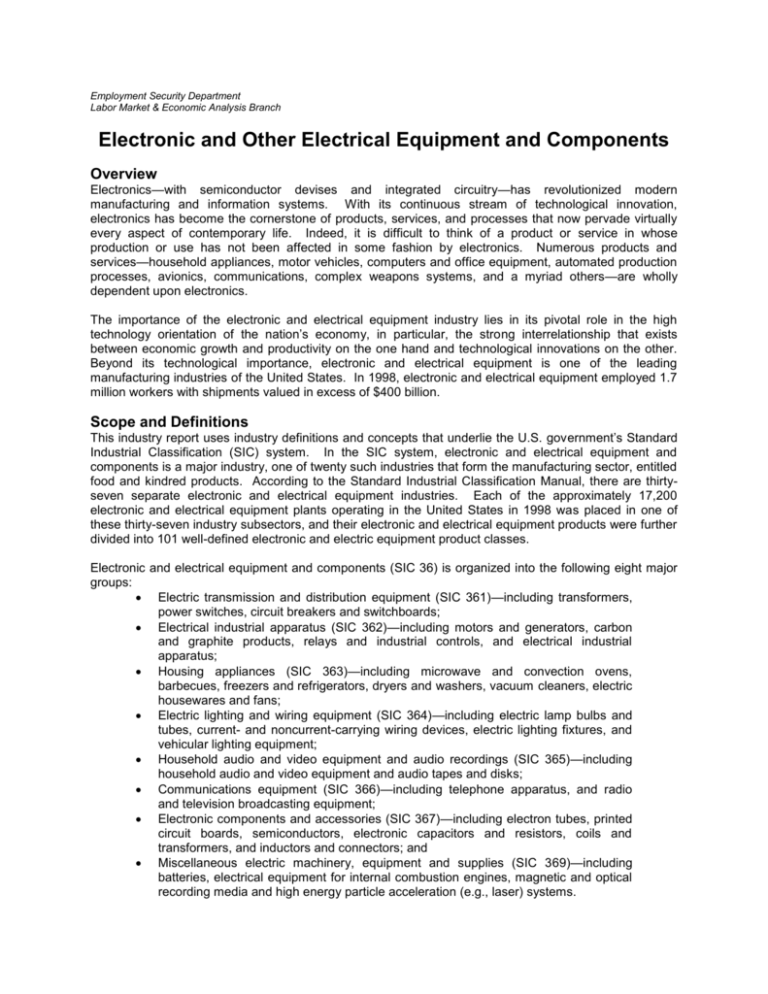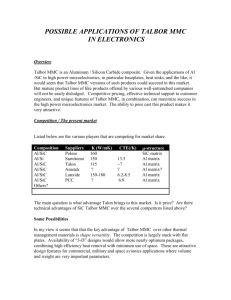Electronic & Other Electrical Equipment & Components
advertisement

Employment Security Department Labor Market & Economic Analysis Branch Electronic and Other Electrical Equipment and Components Overview Electronics—with semiconductor devises and integrated circuitry—has revolutionized modern manufacturing and information systems. With its continuous stream of technological innovation, electronics has become the cornerstone of products, services, and processes that now pervade virtually every aspect of contemporary life. Indeed, it is difficult to think of a product or service in whose production or use has not been affected in some fashion by electronics. Numerous products and services—household appliances, motor vehicles, computers and office equipment, automated production processes, avionics, communications, complex weapons systems, and a myriad others—are wholly dependent upon electronics. The importance of the electronic and electrical equipment industry lies in its pivotal role in the high technology orientation of the nation’s economy, in particular, the strong interrelationship that exists between economic growth and productivity on the one hand and technological innovations on the other. Beyond its technological importance, electronic and electrical equipment is one of the leading manufacturing industries of the United States. In 1998, electronic and electrical equipment employed 1.7 million workers with shipments valued in excess of $400 billion. Scope and Definitions This industry report uses industry definitions and concepts that underlie the U.S. government’s Standard Industrial Classification (SIC) system. In the SIC system, electronic and electrical equipment and components is a major industry, one of twenty such industries that form the manufacturing sector, entitled food and kindred products. According to the Standard Industrial Classification Manual, there are thirtyseven separate electronic and electrical equipment industries. Each of the approximately 17,200 electronic and electrical equipment plants operating in the United States in 1998 was placed in one of these thirty-seven industry subsectors, and their electronic and electrical equipment products were further divided into 101 well-defined electronic and electric equipment product classes. Electronic and electrical equipment and components (SIC 36) is organized into the following eight major groups: Electric transmission and distribution equipment (SIC 361)—including transformers, power switches, circuit breakers and switchboards; Electrical industrial apparatus (SIC 362)—including motors and generators, carbon and graphite products, relays and industrial controls, and electrical industrial apparatus; Housing appliances (SIC 363)—including microwave and convection ovens, barbecues, freezers and refrigerators, dryers and washers, vacuum cleaners, electric housewares and fans; Electric lighting and wiring equipment (SIC 364)—including electric lamp bulbs and tubes, current- and noncurrent-carrying wiring devices, electric lighting fixtures, and vehicular lighting equipment; Household audio and video equipment and audio recordings (SIC 365)—including household audio and video equipment and audio tapes and disks; Communications equipment (SIC 366)—including telephone apparatus, and radio and television broadcasting equipment; Electronic components and accessories (SIC 367)—including electron tubes, printed circuit boards, semiconductors, electronic capacitors and resistors, coils and transformers, and inductors and connectors; and Miscellaneous electric machinery, equipment and supplies (SIC 369)—including batteries, electrical equipment for internal combustion engines, magnetic and optical recording media and high energy particle acceleration (e.g., laser) systems. Under this classification, the electronic and electrical equipment industry does not include computers and office equipment, which is classified under industrial machinery. Figure 1 Electronic & Electrical Equipment 1996 Value of Production: United States and Washington Source: U.S. Bureau of the Census, Annual Survey of Manufacturers 60.0% Share of Total Production 50.0% United States W ashington 40.0% 30.0% 20.0% 10.0% 0.0% Electrical industrial Electric lighting & Household audio & apparatus wiring equipment video equipment Communications equipment Electronic components & accessories Other electronic & electrical equipment Semiconductors The lion’s share of U.S. and Washington employment and production in electronic and electrical equipment is found in electronic components and accessories. These semiconductors are the fundamental building blocks for the electronics industry. Numerous industries, such as computer, telecommunications, instruments, medical equipment, and transportation use these electronic component products. In 1998, 39 percent of total U.S. employment and production was in semiconductors and other components. For Washington, more than half of the state’s employment and production in electronic and electrical equipment was in semiconductors and other components. Technological innovation is the driving force behind this leading edge semiconductor industry. The history of the semiconductor industry during its forty years of existence is one of continuous technical progress that has the enhanced component performance and reliability, increased the variety of components, and increased component integration. A major factor in accelerating demand is the significant growth in applications. The importance of semiconductors derives not so much from its pervasive use as from the fact that technological progress in many of these end-use markets (e.g., computers, telecommunications, industrial automated processes, instruments, military equipment) cannot be disassociated with semiconductor technology. Current Status In 1998, Washington electronic and electrical equipment industry employed 18,200 workers; representing roughly 5 percent of the state’s manufacturing work force. Recent growth in electronic and electrical equipment has been explosive; since 1992 the industry has added more than two-fifths of its current work force. Recent growth of the industry has been advanced by major plant expansion announcements by world-wide leaders in the semiconductor industry—Intel, SEH America, and Matsushita. However, the Asian financial crisis has sent a chill throughout the national semiconductor industry. Semiconductor firms in Washington State have not escaped unscathed, resulting in cancelled plans and closures. Figure 2 Employment in Washington Electronic & Electrical Equipment Industry, 1961-1998 Source: Washington Employment Security Department 20,000 18,000 16,000 Total employment 14,000 12,000 10,000 8,000 6,000 4,000 2,000 0 1961 1964 1967 1970 1973 1976 1979 1982 1985 1988 1991 1994 1997 Similar to the national industry, electronic and electrical equipment in the state is dominated by the electronic components and accessories subsector, which accounts for over a half of the total employment in electronic and electrical equipment. Formerly the largest subsector, communications equipment now accounts for about 17 percent of electronic and electrical equipment’s total employment. Of the various subsectors, household audio and video equipment and electronic components have been the stellar performers since 1981, expanding seven-fold and three-fold, respectively. Figure 3 Number of Employers in Washington Electronic and Electrical Equipment Industry, 1981-1998 Source: Washington Employment Security Department. 400 Number of establishments 350 300 250 200 150 100 50 0 1981 1982 1983 1984 1985 1986 1987 1988 1989 1990 1991 1992 1993 1994 1995 1996 1997 1998 Electronic components Other electronic & electric equipment Figure 4 Employment in Washington Electronic Components & Accessories and Other Electronic & Electrical Equipment, 1981-1998 Source: Washington Employment Security Department. 20,000 18,000 16,000 Total employment 14,000 12,000 10,000 8,000 6,000 4,000 2,000 0 1981 1982 1983 1984 1985 1986 1987 1988 1989 1990 1991 1992 1993 1994 1995 1996 1997 1998 Electronic components & accessories Other electronic & electric equipment Electronic and electrical equipment in Washington is largely composed of small shops that manufacture electronic equipment and components, produce finished products, and do custom work for industrial niches. Seven of the subsectors (electric transmission and distribution, electric industrial apparatus, household appliances, electric lighting and wiring equipment, household audio and video equipment, communications equipment, and miscellaneous electrical machinery) account for about two-thirds of the total 340 establishments, yet they average around 38 employees per establishment. By contrast, the electronic components subsector averages over 80 employees per establishment. Over 55 percent of all electronic components workers are found in establishments with 250 or more employees. Figure 5 Size of Establishments of Washington Electronic and Electrical Equipment Industry, 1998 Source: Washington Employment Security Department Share of total employment 45.0% 40.0% State 35.0% Electronic & electrical equipment Electronic components & accessories 30.0% 25.0% 20.0% 15.0% 10.0% 5.0% 0.0% 1-19 20-49 50-99 100-249 N umber of employees per establishment 250-499 500+ Average covered wages for electronic and electrical equipment workers was $37,223 in 1998, about 10 percent above the statewide nonfarm average of $33,922. Electronic components employees, earned slightly less than the industry average at $35,009. The distribution of hourly wages for both electronic and electrical equipment and electronic components is similar to the state, with a pronounced disposition toward lower hourly wages. Nearly sixty percent of all workers in the electronic and electrical equipment industry earns less than $12 per hour, compared with all nonfarm workers in the state in which 46 percent earn between $6 and $12 per hour. Table 1 Real Average Wages for Washington Covered Electronic & Electrical Equipment Workers, 1981-1998 (1998$) Sources: Washington Employment Security Department, U.S. Bureau of Economic Analysis Sector 1981 1983 1985 1987 1989 1991 1993 1995 1997 1998 Electric Distribution Equip. $31,769 $32,220 $32,744 $30,730 $31,374 $31,944 $33,393 $36,754 $37,557 $39,548 Electrical Industrial Apparatus $32,049 $34,357 $32,854 $32,027 $30,444 $32,074 $30,503 $31,694 $34,492 $35,594 Household Appliances $34,136 $32,761 $29,498 $31,485 $27,140 $27,097 $30,759 $27,606 $32,839 $33,474 Electric Lighting & Wiring Equip. $26,292 $26,212 $25,905 $27,248 $26,851 $27,073 $28,339 $26,240 $30,887 $29,479 Household Audio & Video Equip. $28,142 $24,598 $24,993 $24,321 $23,977 $24,118 $26,104 $27,364 $28,494 $28,711 Communications Equip. $34,004 $35,972 $38,161 $39,774 $32,197 $41,332 $35,606 $40,026 $45,164 $47,636 Electronic Components and Access $28,885 $32,576 $31,648 $31,418 $31,298 $32,429 $31,210 $32,586 $35,205 $36,740 Misc. Electrical Equip. & Supplies $31,095 $33,903 $23,347 $23,496 $20,630 $19,530 $24,048 $24,237 $29,032 $34,106 Total, Electronic & Electrical Equip. $31,572 $33,481 $33,243 $33,470 $29,906 $31,553 $30,814 $32,557 $35,923 $37,223 Total State Manufacturing $38,352 $37,909 $38,024 $37,876 $37,338 $37,667 $38,018 $38,942 $40,954 $42,247 Total State Nonfarm $28,783 $27,789 $27,313 $27,304 $27,167 $27,928 $28,575 $29,046 $31,504 $33,922 Figure 6 Average Hourly Wages for Washington Electronic & Electrical Equipment Workers, 1997 Source: Washington Employment Security Department 25.0% State Share of Total Employment 20.0% Electronic & electrical equipment Electronic components & accessories 15.0% 10.0% 5.0% 0.0% <$6 $6-$8 $8-$10 $10-$12 $12-$14 $14-$16 $16-$18 $18-$20 $20-$22 $22-$24 $24-$26 >$26 A verage Hourly W age The labor force in the electronic and electrical equipment sector is dominated by operatives and laborers. Common electronic and electrical equipment occupations within this group are assemblers, machinists, inspectors and graders. Professional and technical and clerical occupations are also important in electronic and electrical equipment. Although the majority of electronic components workers are within the operatives and laborer grouping, a sizable share of the subsector’s employees are classified as professional and technical workers. This greater proportion of professional and technical helps to explain the difference in wages between electronic components and the rest of electronic and electrical equipment. Table 2 Occupational Profile of Electronic & Electrical Equipment Workers in Washington, 1998 and 2008 Source: Washington Employment Security Department Estimated 1998 Projected 2008 Percent of Percent of Electronic & Electrical Equipment, SIC 36 Estimated Total Projected Total Employment Employment Employment Employment Managerial & Administrative Professional, Paraprofessional & Technical Sales & Related Occupations Clerical & Administrative Support Service Occupations Production, Operating & Maintenance Operators, Helpers & Laborers Undefined Occupations TOTAL 1,493 2,576 472 1,748 75 1,750 7,825 1,889 17,828 8.4% 14.5% 2.7% 9.8% 0.4% 9.8% 43.9% 10.6% 100.0% 2,194 4,320 645 2,304 93 2,331 12,082 3,071 27,040 8.1% 16.0% 2.4% 8.5% 0.3% 8.6% 44.7% 11.4% 100.0% Table 3 Occupational Profile of Electronic Components Workers in Washington, 1995 and 2005 Source: Washington Employment Security Department Estimated 1995 Projected 2005 Percent of Percent of Electronic Components, SIC 367 Estimated Total Projected Total Employment Employment Employment Employment TOTAL Managerial & Administrative Professional/Paraprofessional & Technical Sales & Related Clerical & Administrative Support Service Agricultural, Forestry, Fishing & Related Product/Construct/Operate/Maintenance/Material Handling 6,703 564 1,222 189 851 50 0 3,827 100.0% 8.4% 18.2% 2.8% 12.7% 0.7% 0.0% 57.1% 13,003 1,108 2,744 389 1,577 88 0 7,096 100.0% 8.5% 21.1% 3.0% 12.1% 0.7% 0.0% 54.6% Note: Estimated employment and projected employment are harmonized with ES-202 and LongTerm Economic Forecasts produced by LMEA Unit; Occupational group shares are consistent with prior surveys produced by OES Unit. Contribution of Electronic and Electrical Equipment to the Washington State Economy Compared to the nation, the relative importance of electronic and electrical equipment to the Washington economy is low. Until 1996, the index of specialization for Washington electronic and electrical equipment has remained below 0.5 since 1987 (an index of 1.0 signals the same importance of an industry for Washington as for the U.S.). The principal reason behind electronic and electrical equipment’s increased relative importance is the electronic components subsector. Since 1993, electronic components’ relative importance has trended upward; its index of specialization in 1996 was 0.75. Figure 7 Index of Specialization: Washington Electronic & Electrical Equipment, 1987-1996 Source: U.S. Bureau of the Census, Annual Survey of Manufacturers 0.80 0.70 Index of specialization 0.60 0.50 0.40 0.30 0.20 0.10 0.00 1987 1988 1989 1990 1991 1992 Electronic & Electrical Equipment 1993 1994 1995 1996 Electronic Components Electronic components is producing an increasing share of electronic and electrical equipment’s total production. In 1987, establishments produced $400 million of electronic components, 45 percent of the total value of production for the state’s electronic and electrical equipment industry. By 1996, electronic components’ share of total value of production ($2.41 billion) for electronic and electrical equipment had increased to 52 percent. Although most electronic and electrical equipment manufacturers in Washington service regional and domestic markets, an increasing share of production is being exported to foreign customers. According to a recent study, Foreign Exports and the Washington State Economy; more than one-fourth of $2.21 billion of electronic and electrical equipment production in 1995 was exported to foreign markets. In 1998, over $980 million of electronic and electrical equipment produced in Washington was exported to foreign markets. Outlook Electronic and electrical equipment has outperformed the state economy during the last quarter century. Employment in electronic and electrical equipment has risen at a robust 5.6 percent average annual pace since 1971, significantly greater than total nonfarm employment (3.2 percent). Domestic and foreign enduse markets for electronic and electrical equipment are expected to remain strong for the next twenty-five years. The Semiconductor Industry Association has forecast that between 1999 and 2001, global sales of semiconductors will increase between 17-19 percent a year. U.S.-based semiconductor manufacturers will slightly increase their share of the global market to one-third of the predicted $222 billion. The result of this bright outlook is continued expansion within the Washington electronic and electrical equipment. By the year 2020, electronic and electrical equipment manufacturers are forecast to employ 29,650 workers, an average annual growth rate (2000-2020) of 2.6 percent. For the electronic components subsector, employment is forecast to grow at an annual rate of 4.6 percent. Figure 8 Washington Electronic & Electrical Equipment Wage & Salary Employment Forecast, 2000-2020 Sources: Washington Office of Financial Management, Washington Employment Security Department 35,000 30,000 Total employment 25,000 20,000 15,000 10,000 5,000 0 1995 2000 2005 Electronic components 2010 2015 Other electronic & electric equipment 2020



